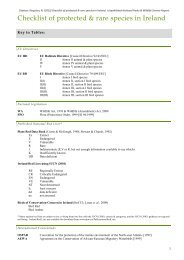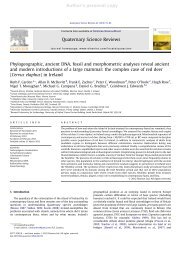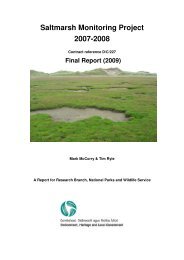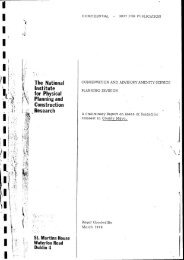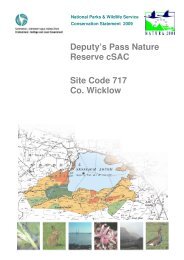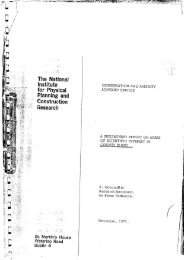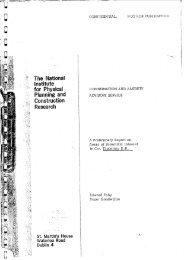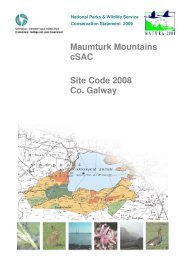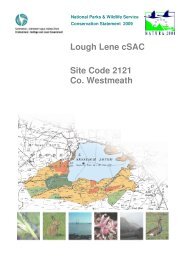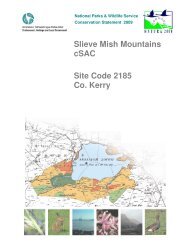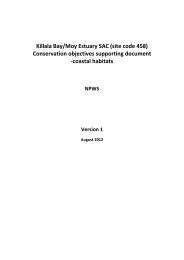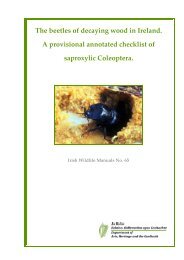The Role of Kelp in the Marine Environment - National Parks ...
The Role of Kelp in the Marine Environment - National Parks ...
The Role of Kelp in the Marine Environment - National Parks ...
You also want an ePaper? Increase the reach of your titles
YUMPU automatically turns print PDFs into web optimized ePapers that Google loves.
<strong>the</strong>m provide lists <strong>of</strong> species from various phyla for Norwegian waters and record 238<br />
taxa (<strong>in</strong>clud<strong>in</strong>g fish) from 58 plants exam<strong>in</strong>ed with an average density <strong>of</strong> 8,000<br />
<strong>in</strong>dividuals per lam<strong>in</strong>arian. Both publications agree that amphipods and gastropods<br />
were <strong>the</strong> most diverse and numerically dom<strong>in</strong>ant groups present but both <strong>the</strong>se<br />
sources underestimate <strong>the</strong> numbers <strong>of</strong> polychaete species (see Healy and McGrath<br />
(1998) for a more extensive list<strong>in</strong>g <strong>of</strong> polychaetes). Birkett et al. (1998) provide<br />
figures for classes and higher taxa and <strong>the</strong>se total to ca. 1,260, some 173 <strong>of</strong> which are<br />
polychaetes. <strong>The</strong>se same authors list three species <strong>of</strong> ctenophores; however, as<br />
ctenophores are exclusively planktonic, <strong>the</strong>y cannot be regarded as liv<strong>in</strong>g <strong>in</strong>/on (or<br />
dependant upon) kelp forests. Edwards (op. cit.), work<strong>in</strong>g <strong>in</strong> Bantry and Dunmanus<br />
Bays <strong>in</strong> <strong>the</strong> south west Ireland, noted that decreases <strong>in</strong> diversity and depths to which<br />
plants could grow were related to levels <strong>of</strong> suspended solids. Open water forests<br />
could live <strong>in</strong> deeper depths and had greater numbers <strong>of</strong> associated species whereas<br />
<strong>in</strong>shore kelp communities, liv<strong>in</strong>g at <strong>the</strong> ends <strong>of</strong> bays where freshwater <strong>in</strong>flow and<br />
wave action <strong>in</strong>creased turbidity, were restricted to ca. < 10 m depth and had few<br />
species. He also noted that suspension feeders dom<strong>in</strong>ated <strong>the</strong>se <strong>in</strong>shore communities,<br />
a feed<strong>in</strong>g group that would benefit from higher levels <strong>of</strong> suspended material. Moore<br />
(1973) had earlier identified turbidity as an important ecological factor regulat<strong>in</strong>g<br />
growth <strong>of</strong> lam<strong>in</strong>arians.<br />
In contrast, Steneck et al. (2004) observed that kelp forests <strong>of</strong>f <strong>the</strong> Gulf <strong>of</strong> Ma<strong>in</strong>e are<br />
naturally low <strong>in</strong> species diversity with only 15 taxa recorded. <strong>The</strong>re are no records <strong>of</strong><br />
sponges, coelenterates, polychaetes, cirripeds, isopods, bryozoans or tunicates, all <strong>of</strong><br />
which are highly associated with kelp forests <strong>in</strong> Ireland. <strong>The</strong>ir absence <strong>in</strong> western<br />
Atlantic kelp forests is hard to understand and pressure from urch<strong>in</strong> graz<strong>in</strong>g cannot be<br />
used to expla<strong>in</strong> this.<br />
Jones (1973), work<strong>in</strong>g <strong>of</strong>f <strong>the</strong> north east coast <strong>of</strong> Brita<strong>in</strong> where water quality is<br />
seriously compromised by pollution, found that holdfast communities were less<br />
diverse than at open water sites with ca. 45% <strong>of</strong> <strong>the</strong> species complement be<strong>in</strong>g absent<br />
from <strong>the</strong>se polluted sites. Species that were rare at <strong>the</strong> open water sites were absent<br />
from <strong>the</strong> polluted site, and no new species were recorded at <strong>the</strong> polluted sites.<br />
However, Abbott and Perk<strong>in</strong>s (1977) and Perk<strong>in</strong>s et al. (1978) report that successive<br />
sampl<strong>in</strong>g <strong>of</strong> lam<strong>in</strong>arian holdfasts over a 6 year period between 1971 and 1976<br />
28



